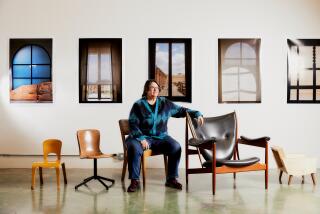Design : How an Idea Became A Chair
- Share via
One of the most successful new ideas in recent years in the highly competitive contract furniture field has been the Rubber Chair.
Made of tubular steel and flexible back supports encased in a synthetic rubber tubing, the Rubber Chair is principally used in office waiting rooms, around conference tables, in classrooms, and in restaurants and lunchrooms.
Since its introduction four years ago, the chair designed by Brian Kane of San Francisco has sold nearly 50,000 models at prices per item in the $400 range, depending on whether the seats are made of maple or are upholstered.
The Rubber Chair also has garnered a variety of industry awards for originality and established the relatively small ($18 million in annual sales) Metropolitan Furniture Corp. as an industry innovator and apparently sweetened for its owners the recent sale of the corporation to the Steelcase Corp.
“Not bad for something that looks like a big tarantula,” said Elvin Case of Metropolitan, sitting in a Rubber Chair alongside designer Kane a few weeks ago in the company’s factory in South San Francisco.
Case said that the idea of the chair was spurred by the company realizing in 1981 that if it were to be successful it had to “penetrate a new market.”
To do that, Case added, the chair needed “the ability to hold up under excessive and hard use; the aesthetics that would separate it from the competition; and be manufactured cost effectively for competitive pricing.”
As for why the chair and not, say, a desk, a table, or a stool, Kane explained that a chair, in particular a side chair for broad institutional and corporate use, was a traditional item designers used to make a mark in the office furniture field.
“It has the potential for both quality and quantity,” Kane said, who before coming to Metropolitan in 1977 worked for Atelier International, and architect Silvio Coppolo in Milan, doing furniture design and development. “If you score with a chair, you can really score big.” Among those whose design reputations have been boosted by chairs are Marcel Breuer, Ero Saarinen and Charles Eames.
The idea of the use of the rubber-like material that has given the chair its name, its distinctive look and desired durability was prompted in part by a materials salesman, according to Kane.
“It was one of those ‘reps’ who comes by the factory and sells things like fasteners, and nuts and bolts,” said Kane. “He was about to leave one day after taking an order and just threw a piece of this rubber on my desk, and asked whether I could use it on something. I said I’d think about it. I don’t even remember his name, and I never saw him again.”
Originally, Kane recalled, he first saw the material used as handgrips on racing bicycles and exercise equipment, and as handles for fishing rods. He thought then about its applicability on furniture but put off doing anything about it.
“Seeing it again when we were thinking about coming up with some new idea for a side chair did it for me,” Kane said. “Here was a material I thought that could hold up under excessive use, was soft and resilient, and could easily slip on or off an inexpensively finished frame.”
The development was not that easy, said Case.
“It never is,” added Kane. “Having an idea is one thing. Making it work is quite another.”
After some research, the rubber material was dropped for a synthetic that had been developed as pipe insulation for the chemical engineering industry. Kane explained the synthetic rubber was colorfast as well as abrasion resistant, fire retardant and stain resistant.
The chair also had to be designed so that the synthetic covering could be slipped on after the frame was completed, which is to say bent, welded and electrostatically powder coated. This meant that there had to be a free end onto which the covering could be slid.
Various prototypes of frames were experimented with, with each prototype becoming simpler and simpler, according to Kane. The eventual solution was four 1-inch diameter steel tubes welded to a rigid rectangular steel-seat structure, with the two front legs curving toward the back to form the arms, and the two back legs rising to form the back rest.
The linking of the two sets of open tubing was the most difficult problem to resolve in providing proper back support. “After much trial and error,” Kane said, “the final solution was a . . . thick polypropylene back strap, covered in rubber and fastened to the flattened tube ends with machine screws.”
This, the designer said, provided a back rest that was flat yet had the ability to yield and conform to body movement. Further, it could be easily inserted after all the rubber elements were in place, so that they could be replaced easily if damaged.
As for the seat, it could be of a molded maple plywood, in a natural or textured color finish, or an upholstered pad in various patterns.
“We knew when we finished the prototype we had something unique, in appearance, and in durability; something that would give us a strong identity in the field,” said Case. “But we didn’t know it would do as well as it did.”
Based on the success of the rubber chair, Metropolitan also has developed a so-called rubber line, featuring a table group, in 18 sizes and heights from low rounds, squares and oval conference tables. There also are a variety of rubber stools and children’s furniture. But the company’s continued leader is the rubber chair.
“It is an idea that worked,” said Kane, with obvious pride.
More to Read
Inside the business of entertainment
The Wide Shot brings you news, analysis and insights on everything from streaming wars to production — and what it all means for the future.
You may occasionally receive promotional content from the Los Angeles Times.










